Stewart J. Calculus
Подождите немного. Документ загружается.

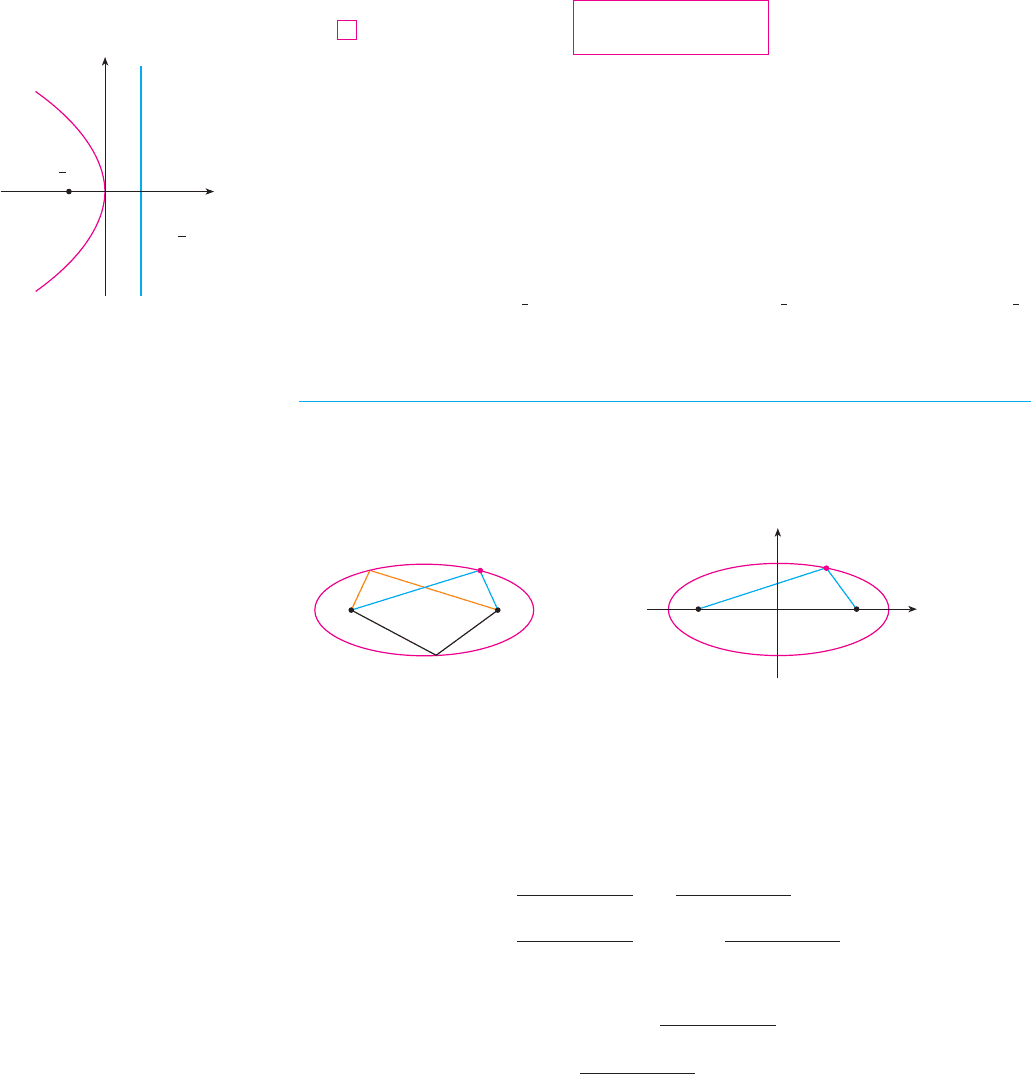
If we interchange and in (1), we obtain
which is an equation of the parabola with focus and directrix . (Inter-
changing and amounts to reflecting about the diagonal line .) The parabola opens
to the right if and to the left if [see Figure 4, parts (c) and (d)]. In both cases
the graph is symmetric with respect to the -axis, which is the axis of the parabola.
EXAMPLE 1 Find the focus and directrix of the parabola and sketch
the graph.
SOLUTION
If we write the equation as and compare it with Equation 2, we see
that , so . Thus the focus is and the directrix is
.
The sketch is shown in Figure 5. M
ELLIPSES
An ellipse is the set of points in a plane the sum of whose distances from two fixed points
and is a constant (see Figure 6). These two fixed points are called the foci (plural of
focus). One of Kepler’s laws is that the orbits of the planets in the solar system are ellipses
with the sun at one focus.
In order to obtain the simplest equation for an ellipse, we place the foci on the -axis at
the points and as in Figure 7 so that the origin is halfway between the foci.
Let the sum of the distances from a point on the ellipse to the foci be . Then
is a point on the ellipse when
that is,
or
Squaring both sides, we have
which simplifies to
We square again:
which becomes !a
2
$ c
2
"x
2
( a
2
y
2
! a
2
!a
2
$ c
2
"
a
2
!x
2
( 2cx ( c
2
( y
2
" ! a
4
( 2a
2
cx ( c
2
x
2
a
s
!x ( c"
2
( y
2
! a
2
( cx
x
2
$ 2cx ( c
2
( y
2
! 4a
2
$ 4a
s
!x ( c"
2
( y
2
( x
2
( 2cx ( c
2
( y
2
s
!x $ c"
2
( y
2
! 2a $
s
!x ( c"
2
( y
2
s
!x ( c"
2
( y
2
(
s
!x $ c"
2
( y
2
! 2a
-
PF
1
-
(
-
PF
2
-
! 2a
P!x, y"2a + 0
!c, 0"!$c, 0"
x
F I G U R E 7
F¡(_c,0) F™(c,0)
0
x
y
P(x,y)
F I G U R E 6
F¡ F™
P
F
2
F
1
x !
5
2
! p, 0" !
(
$
5
2
, 0
)
p ! $
5
2
4p ! $10
y
2
! $10x
y
2
( 10x ! 0
x
p
%
0p + 0
y ! xyx
x ! $p!p, 0"
y
2
! 4px
2
yx
692
|| ||
CHAPTER 11 PARAMETRIC EQUATIONS AND POLAR COORDINATES
F I G U R E 5
0
x
y
x=
5
2
¥+10x=0
”_ ,0’
5
2
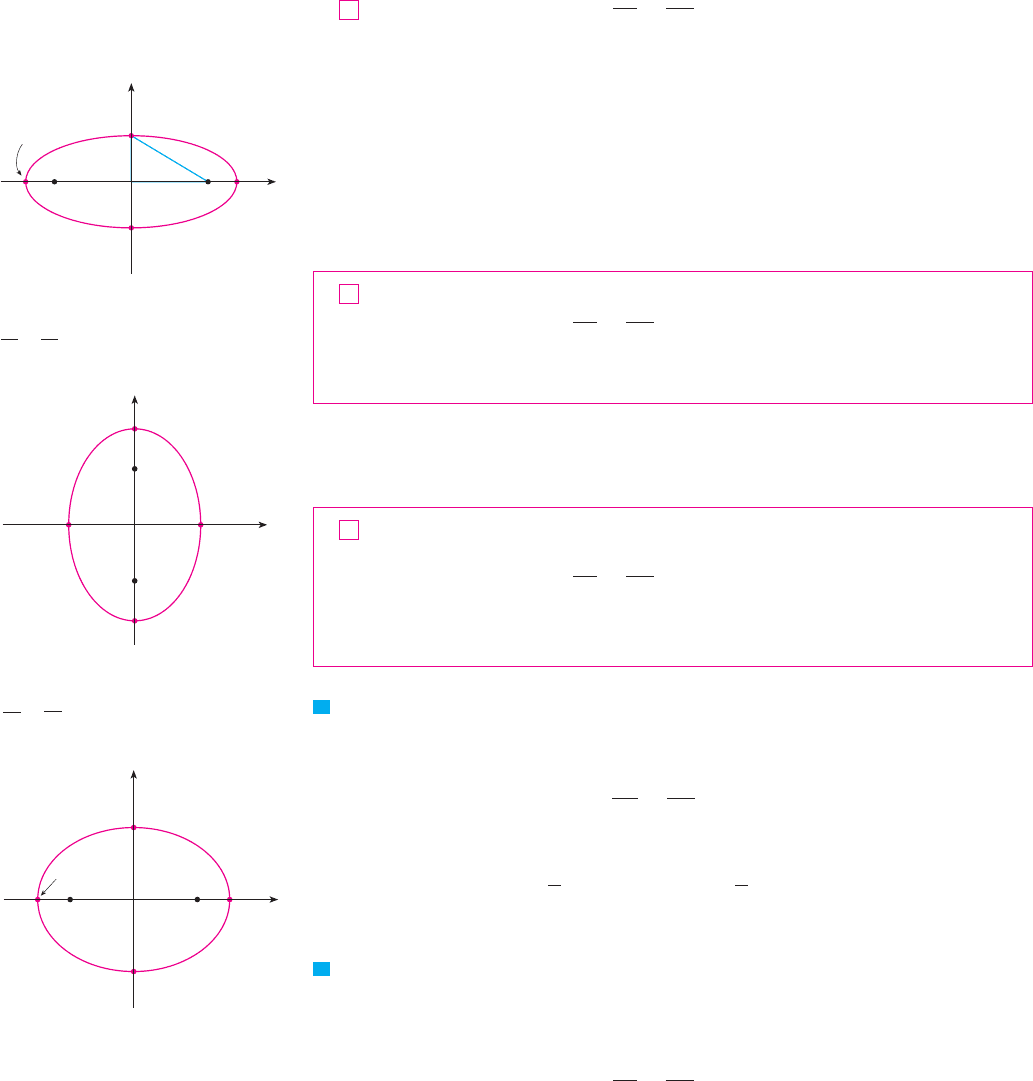
From triangle in Figure 7 we see that , so and therefore
. For convenience, let . Then the equation of the ellipse becomes
or, if both sides are divided by ,
Since , it follows that . The -intercepts are found by setting
. Then , or , so . The corresponding points and
are called the vertices of the ellipse and the line segment joining the vertices
is called the major axis. To find the -intercepts we set and obtain , so
. Equation 3 is unchanged if is replaced by or is replaced by , so the
ellipse is symmetric about both axes. Notice that if the foci coincide, then , so
and the ellipse becomes a circle with radius .
We summarize this discussion as follows (see also Figure 8).
The ellipse
has foci , where , and vertices .
If the foci of an ellipse are located on the -axis at , then we can find its equa-
tion by interchanging and in (4). (See Figure 9.)
The ellipse
has foci , where , and vertices .
EXAMPLE 2 Sketch the graph of and locate the foci.
SOLUTION Divide both sides of the equation by 144:
The equation is now in the standard form for an ellipse, so we have , ,
, and . The -intercepts are and the -intercepts are . Also,
, so and the foci are . The graph is sketched in
Figure 10.
M
EXAMPLE 3 Find an equation of the ellipse with foci and vertices .
SOLUTION Using the notation of (5), we have and . Then we obtain
, so an equation of the ellipse is
Another way of writing the equation is . M
9x
2
( 5y
2
! 45
x
2
5
(
y
2
9
! 1
b
2
! a
2
$ c
2
! 9 $ 4 ! 5
a ! 3c ! 2
!0, ,3"!0, ,2"
V
(
,
s
7
, 0
)
c !
s
7
c
2
! a
2
$ b
2
! 7
,3y,4xb ! 3a ! 4
b
2
! 9a
2
! 16
x
2
16
(
y
2
9
! 1
9x
2
( 16y
2
! 144
V
!0, ,a"c
2
! a
2
$ b
2
!0, ,c"
a ) b + 0
x
2
b
2
(
y
2
a
2
! 1
5
yx
!0, ,c"y
!,a, 0"c
2
! a
2
$ b
2
!,c, 0"
a ) b + 0
x
2
a
2
(
y
2
b
2
! 1
4
r ! a ! b
a ! bc ! 0
$yy$xxy ! ,b
y
2
! b
2
x ! 0y
!$a, 0"
!a, 0"x ! ,ax
2
! a
2
x
2
'a
2
! 1y ! 0
xb
%
ab
2
! a
2
$ c
2
%
a
2
x
2
a
2
(
y
2
b
2
! 1
3
a
2
b
2
b
2
x
2
( a
2
y
2
! a
2
b
2
b
2
! a
2
$ c
2
a
2
$ c
2
+ 0
c
%
a2c
%
2aF
1
F
2
P
SECTION 11.5 CONIC SECTIONS
|| ||
693
+ =1,
F I G U R E 8
≈
a@
¥
b@
(c,0)
0
x
y
a
b
c
(0,b)
(_c,0)
(0,_b)
(a,0)
(_a,0)
a˘b
0
x
y
(0,a)
(0,c)
(b,0)
(0,_c)
(_b,0)
(0,_a)
≈
b@
¥
a@
+ =1, a˘b
F I G U R E 9
0
x
y
(0,3)
{œ„7,0}
(4,0)
(_4,0)
(0,_3)
{_œ„7,0}
F I G U R E 1 0
9≈+16¥=144
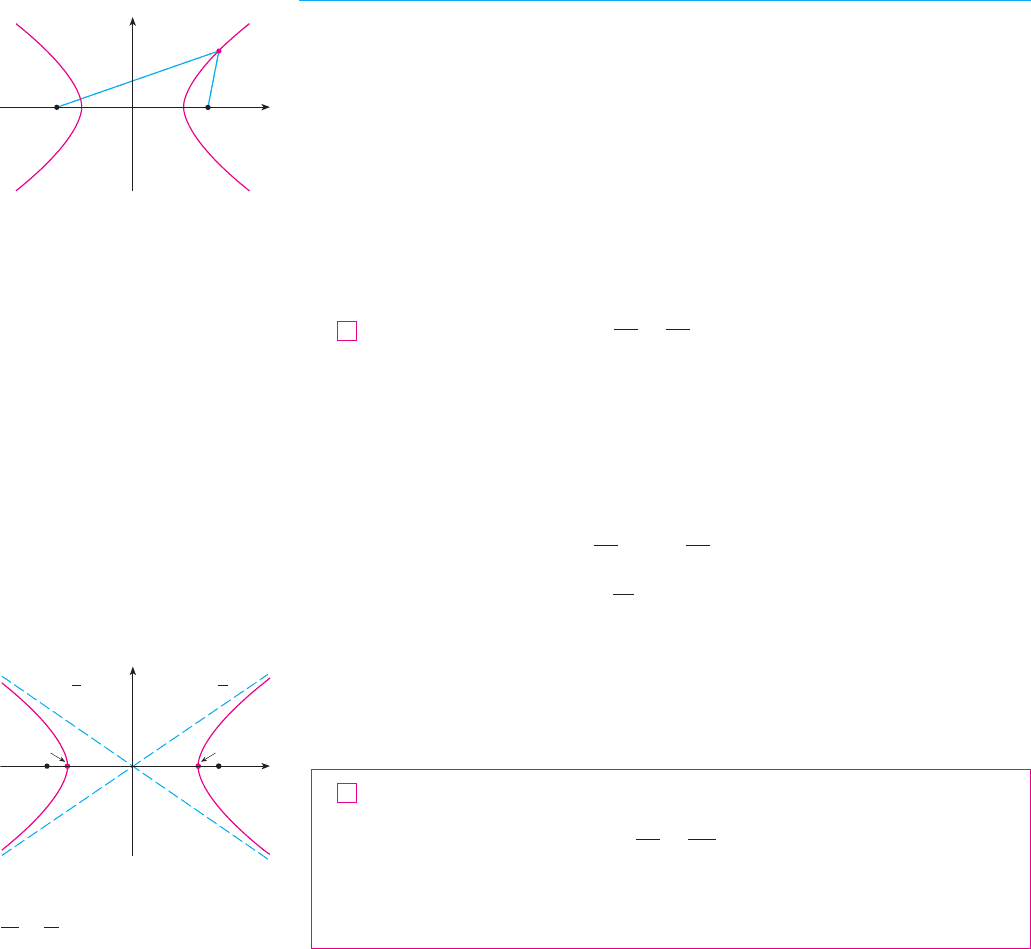
Like parabolas, ellipses have an interesting reflection property that has practical conse-
quences. If a source of light or sound is placed at one focus of a surface with elliptical
cross-sections, then all the light or sound is reflected off the surface to the other focus (see
Exercise 63). This principle is used in lithotripsy, a treatment for kidney stones. A reflec-
tor with elliptical cross-section is placed in such a way that the kidney stone is at one focus.
High-intensity sound waves generated at the other focus are reflected to the stone and
destroy it without damaging surrounding tissue. The patient is spared the trauma of sur-
gery and recovers within a few days.
HYPERBOLAS
A hyperbola is the set of all points in a plane the difference of whose distances from two
fixed points and (the foci) is a constant. This definition is illustrated in Figure 11.
Hyperbolas occur frequently as graphs of equations in chemistry, physics, biology, and
economics (Boyle’s Law, Ohm’s Law, supply and demand curves). A particularly signifi-
cant application of hyperbolas is found in the navigation systems developed in World Wars
I and II (see Exercise 51).
Notice that the definition of a hyperbola is similar to that of an ellipse; the only change
is that the sum of distances has become a difference of distances. In fact, the derivation of
the equation of a hyperbola is also similar to the one given earlier for an ellipse. It is left
as Exercise 52 to show that when the foci are on the -axis at and the difference of
distances is , then the equation of the hyperbola is
where . Notice that the -intercepts are again and the points and
are the vertices of the hyperbola. But if we put in Equation 6 we get
, which is impossible, so there is no -intercept. The hyperbola is symmetric
with respect to both axes.
To analyze the hyperbola further, we look at Equation 6 and obtain
This shows that , so . Therefore we have or . This
means that the hyperbola consists of two parts, called its branches.
When we draw a hyperbola it is useful to first draw its asymptotes, which are the dashed
lines and shown in Figure 12. Both branches of the hyperbola
approach the asymptotes; that is, they come arbitrarily close to the asymptotes. [See
Exercise 55 in Section 4.5, where these lines are shown to be slant asymptotes.]
The hyperbola
has foci , where , vertices , and asymptotes
.y ! ,!b'a"x
!,a, 0"c
2
! a
2
( b
2
!,c, 0"
x
2
a
2
$
y
2
b
2
! 1
7
y ! $!b'a"xy ! !b'a"x
x & $ax ) a
-
x
-
!
s
x
2
) ax
2
) a
2
x
2
a
2
! 1 (
y
2
b
2
) 1
yy
2
! $b
2
x ! 0!$a, 0"
!a, 0",axc
2
! a
2
( b
2
x
2
a
2
$
y
2
b
2
! 1
6
-
PF
1
-
$
-
PF
2
-
! ,2a
!,c, 0"x
F
2
F
1
694
|| ||
CHAPTER 11 PARAMETRIC EQUATIONS AND POLAR COORDINATES
F I G U R E 1 1
P is on the hyperbola when
|PF¡|-|PF™|=,2a.
F™(c,0)F¡(_c,0)
0
x
y
P(x,y)
(a,0)
F I G U R E 1 2
¥
b@
- =1
≈
a@
(c,0)
0
x
y
(_c,0)
(_a,0)
y=_ x
b
a
y= x
b
a

If the foci of a hyperbola are on the -axis, then by reversing the roles of and we
obtain the following information, which is illustrated in Figure 13.
The hyperbola
has foci , where , vertices , and asymptotes
.
EXAMPLE 4 Find the foci and asymptotes of the hyperbola and sketch
its graph.
SOLUTION If we divide both sides of the equation by 144, it becomes
which is of the form given in (7) with and . Since , the
foci are . The asymptotes are the lines and . The graph is shown
in Figure 14. M
EXAMPLE 5 Find the foci and equation of the hyperbola with vertices and
asymptote .
SOLUTION From (8) and the given information, we see that and . Thus
and . The foci are and the equation of the
hyperbola is
M
SHIFTED CONICS
As discussed in Appendix C, we shift conics by taking the standard equations (1), (2), (4),
(5), (7), and (8) and replacing and by and .
EXAMPLE 6 Find an equation of the ellipse with foci , and vertices
, .
SOLUTION The major axis is the line segment that joins the vertices ,
and has length , so . The distance between the foci is , so . Thus
. Since the center of the ellipse is , we replace and in (4)
by and to obtain
as the equation of the ellipse.
M
!x $ 3"
2
4
(
!y ( 2"
2
3
! 1
y ( 2x $ 3
yx!3, $2"b
2
! a
2
$ c
2
! 3
c ! 12a ! 24
!5, $2"!1, $2"
!5, $2"!1, $2"
!4, $2"!2, $2"
y $ kx $ hyx
y
2
$ 4x
2
! 1
(
0, ,
s
5
'2
)
c
2
! a
2
( b
2
!
5
4
b ! a'2 !
1
2
a'b ! 2a ! 1
y ! 2x
!0, ,1"
y ! $
3
4
xy !
3
4
x!,5, 0"
c
2
! 16 ( 9 ! 25b ! 3a ! 4
x
2
16
$
y
2
9
! 1
9x
2
$ 16y
2
! 144
y ! ,!a'b"x
!0, ,a"c
2
! a
2
( b
2
!0, ,c"
y
2
a
2
$
x
2
b
2
! 1
8
yxy
SECTION 11.5 CONIC SECTIONS
|| ||
695
0
x
y
(0,c)
(0,_c)
(0,a)
(0,_a)
y=_
x
a
b
a
b
y= x
F I G U R E 1 3
≈
b@
- =1
¥
a@
F I G U R E 1 4
9≈-16¥=144
0
x
y
(5,0)(_5,0)
(4,0)
(_4,0)
y=_ x
3
4
y= x
3
4
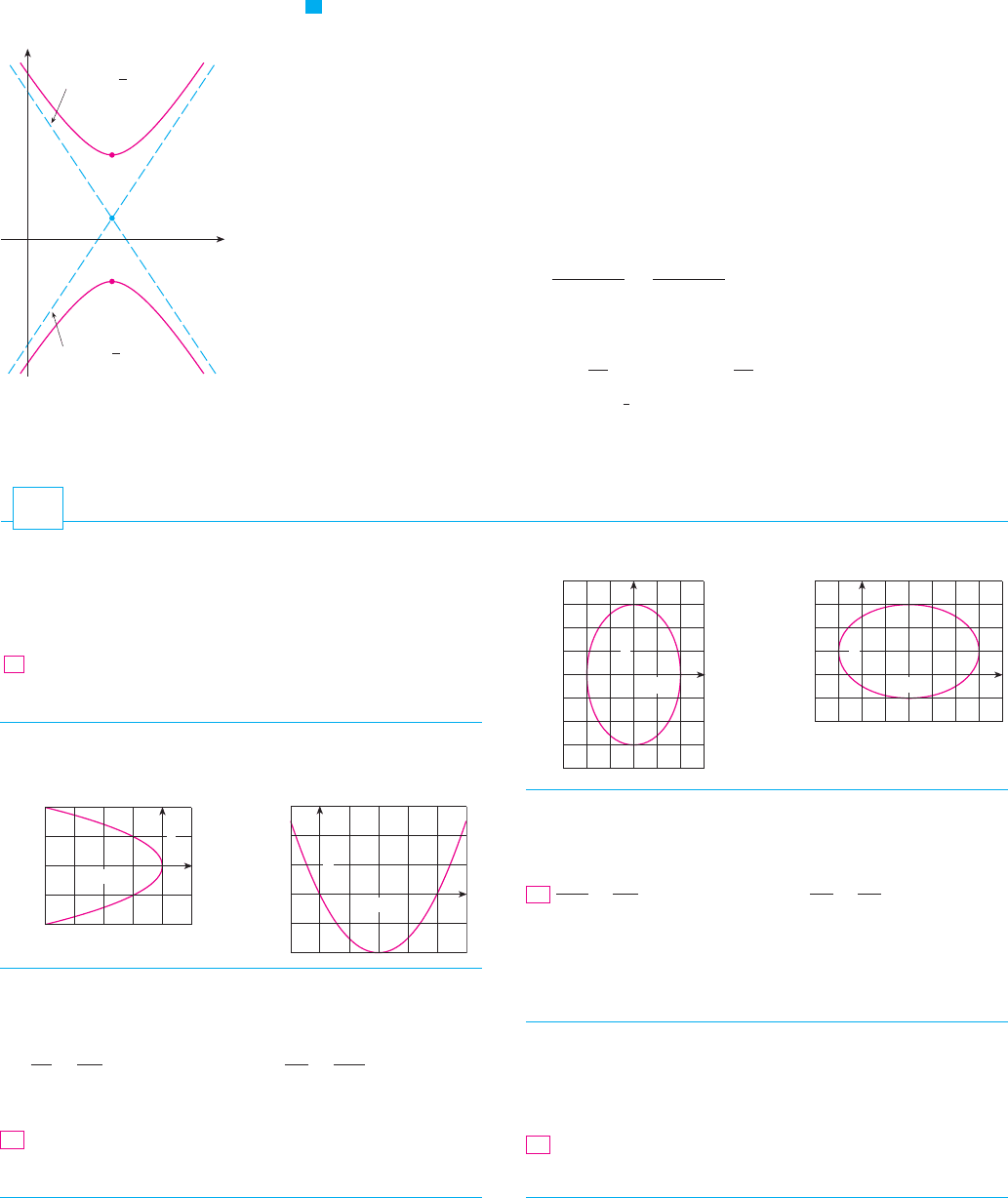
17–18 Find an equation of the ellipse. Then find its foci.
17. 18.
19–24 Find the vertices, foci, and asymptotes of the hyperbola and
sketch its graph.
20.
21. 22.
23.
24.
25–30 Identify the type of conic section whose equation is given
and find the vertices and foci.
25. 26.
28.
29. 30.
4x
2
! 4x ! y
2
! 0y
2
! 2y ! 4x
2
! 3
y
2
" 8y ! 6x " 16x
2
! 4y " 2y
2
27.
x
2
! y
2
! 1x
2
! y ! 1
y
2
" 4x
2
" 2y ! 16x ! 31
4x
2
" y
2
" 24x " 4y ! 28 ! 0
9x
2
" 4y
2
! 36y
2
" x
2
! 4
y
2
16
"
x
2
36
! 1
x
2
144
"
y
2
25
! 1
19.
y
x
1
2
y
x
1
1
0
1– 8 Find the vertex, focus, and directrix of the parabola and sketch
its graph.
1. 2.
3. 4.
6.
7. 8.
9–10 Find an equation of the parabola. Then find the focus and
directrix.
9. 10.
11–16 Find the vertices and foci of the ellipse and sketch
its graph.
11. 12.
13. 14.
16.
x
2
! 3y
2
! 2x " 12y ! 10 ! 0
9x
2
" 18x ! 4y
2
! 27
15.
4x
2
! 25y
2
! 254x
2
! y
2
! 16
x
2
64
!
y
2
100
! 1
x
2
9
!
y
2
5
! 1
y
x
1
20
y
x
1
_2
y ! 12x " 2x
2
! 16y
2
! 2y ! 12x ! 25 ! 0
x " 1 ! !y ! 5"
2
!x ! 2"
2
! 8! y " 3"
5.
y
2
! 12x4x
2
! "y
4y ! x
2
! 0x ! 2y
2
E X E R C I S E S
11.5
696
|| ||
CHAPTER 11 PARAMETRIC EQUATIONS AND POLAR COORDINATES
EXAMPLE 7 Sketch the conic
and find its foci.
SOLUTION We complete the squares as follows:
This is in the form (8) except that and are replaced by and . Thus
, , and . The hyperbola is shifted four units to the right and one
unit upward. The foci are and and the vertices are and
. The asymptotes are . The hyperbola is sketched in
Figure 15.
M
y " 1 ! #
3
2
!x " 4"!4, "2"
!4, 4"
(
4, 1 "
s
13
)(
4, 1 !
s
13
)
c
2
! 13b
2
! 4a
2
! 9
y " 1x " 4yx
!y " 1"
2
9
"
!x " 4"
2
4
! 1
4!y " 1"
2
" 9!x " 4"
2
! 36
4!y
2
" 2y ! 1" " 9!x
2
" 8x ! 16" ! 176 ! 4 " 144
4!y
2
" 2y" " 9!x
2
" 8x" ! 176
9x
2
" 4y
2
" 72x ! 8y ! 176 ! 0
V
F I G U R E 1 5
9≈-4¥-72x+8y+176=0
0
x
y
y-1=_ (x-4)
3
2
y-1= (x-4)
3
2
(4,4)
(4,_2)
(4,1)
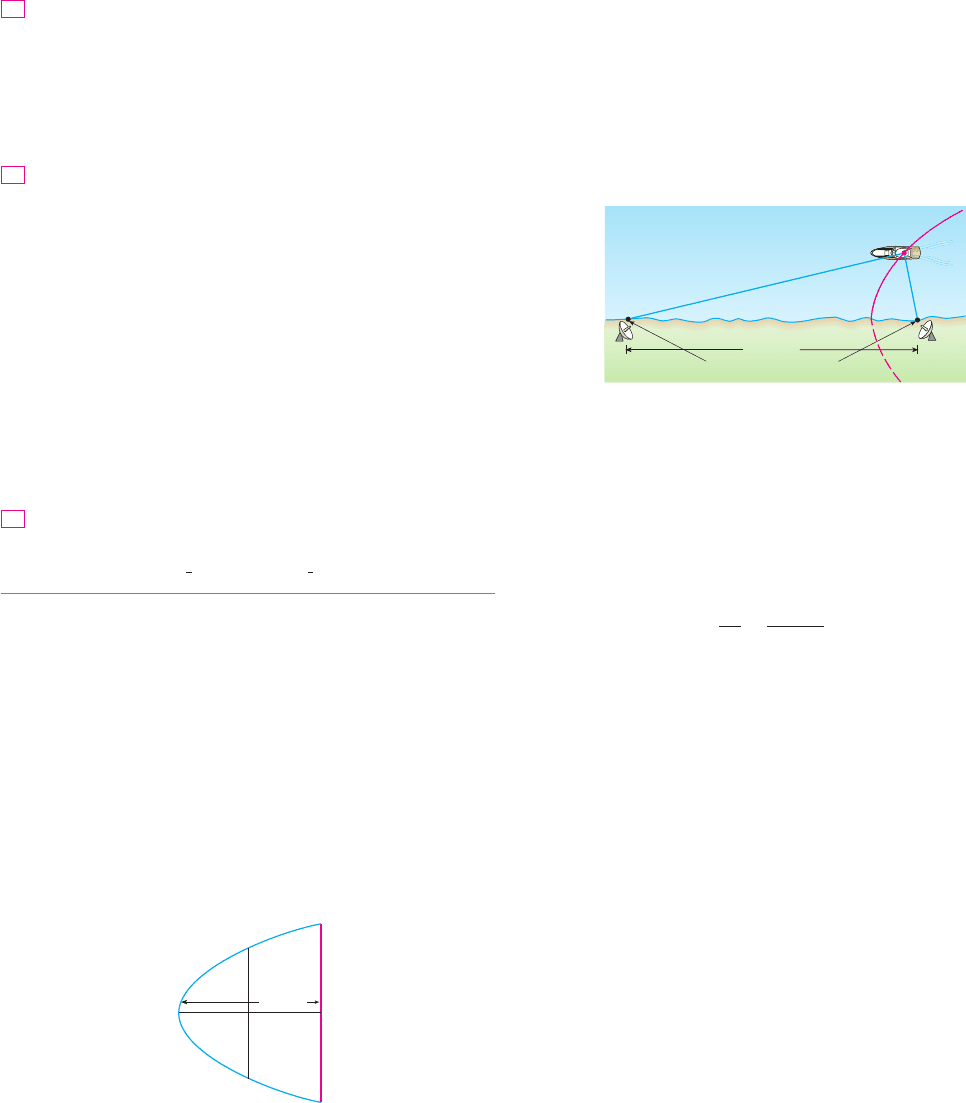
SECTION 11.5 CONIC SECTIONS
|| ||
697
51. In the LORAN (LOng RAnge Navigation) radio navigation
system, two radio stations located at and transmit simul-
taneous signals to a ship or an aircraft located at . The
onboard computer converts the time difference in receiving
these signals into a distance difference , and
this, according to the definition of a hyperbola, locates the
ship or aircraft on one branch of a hyperbola (see the figure).
Suppose that station B is located 400 mi due east of station A
on a coastline. A ship received the signal from B 1200 micro-
seconds ($s) before it received the signal from A.
(a) Assuming that radio signals travel at a speed of 980 ft $s,
find an equation of the hyperbola on which the ship lies.
(b) If the ship is due north of , how far off the coastline is
the ship?
52. Use the definition of a hyperbola to derive Equation 6 for a
hyperbola with foci and vertices .
53. Show that the function defined by the upper branch of the
hyperbola is concave upward.
54. Find an equation for the ellipse with foci and
and major axis of length 4.
55. Determine the type of curve represented by the equation
in each of the following cases: (a) , (b) ,
and (c) .
(d) Show that all the curves in parts (a) and (b) have the same
foci, no matter what the value of is.
56. (a) Show that the equation of the tangent line to the parabola
at the point can be written as
(b) What is the -intercept of this tangent line? Use this fact to
draw the tangent line.
57. Show that the tangent lines to the parabola drawn
from any point on the directrix are perpendicular.
58. Show that if an ellipse and a hyperbola have the same foci,
then their tangent lines at each point of intersection are
perpendicular.
59. Use Simpson’s Rule with to estimate the length of the
ellipse .
60. The planet Pluto travels in an elliptical orbit around the sun
(at one focus). The length of the major axis is km 1.18 % 10
10
x
2
! 4y
2
! 4
n ! 10
x
2
! 4py
x
y
0
y ! 2p!x ! x
0
"
!x
0
, y
0
"y
2
! 4px
k
k
&
0
0
&
k
&
16
k ' 16
x
2
k
!
y
2
k " 16
! 1
!"1, "1"!1, 1"
y
2
#a
2
" x
2
#b
2
! 1
!#a, 0"!#c, 0"
400 mi
transmitting stations
coastline
A
B
P
B
#
$
PA
$
"
$
PB
$
P
BA
31– 48 Find an equation for the conic that satisfies the given
conditions.
31. Parabola, vertex , focus
32. Parabola, vertex , directrix
Parabola, focus , directrix
34. Parabola, focus , vertex
35. Parabola, vertex , vertical axis,
passing through
36. Parabola, horizontal axis,
passing through , , and
Ellipse, foci , vertices
38. Ellipse, foci , vertices
39. Ellipse, foci , , vertices ,
40. Ellipse, foci , , vertex
41. Ellipse, center , vertex , focus
42. Ellipse, foci , passing through
43. Hyperbola, vertices , foci
44. Hyperbola, vertices , foci
45. Hyperbola, vertices , ,
foci ,
46. Hyperbola, vertices , ,
foci ,
Hyperbola, vertices , asymptotes
48. Hyperbola, foci , ,
asymptotes and
49. The point in a lunar orbit nearest the surface of the moon is
called perilune and the point farthest from the surface is called
apolune. The Apollo 11 spacecraft was placed in an elliptical
lunar orbit with perilune altitude 110 km and apolune altitude
314 km (above the moon). Find an equation of this ellipse if
the radius of the moon is 1728 km and the center of the moon
is at one focus.
50. A cross-section of a parabolic reflector is shown in the figure.
The bulb is located at the focus and the opening at the focus
is 10 cm.
(a) Find an equation of the parabola.
(b) Find the diameter of the opening , 11 cm from
the vertex.
5 cm
5 cm
A
B
C
D
V
F
11 cm
$
CD
$
y ! 5 "
1
2
xy ! 3 !
1
2
x
!2, 8"!2, 0"
y ! #2x!#3, 0"
47.
!8, 2"!"2, 2"
!7, 2"!"1, 2"
!"3, 9"!"3, "7"
!"3, 6"!"3, "4"
!0, #5"!0, #2"
!#5, 0"!#3, 0"
!"4, 1.8"!#4, 0"
!"1, 6"!"1, 0"!"1, 4"
!9, "1"!8, "1"!0, "1"
!0, 8"!0, 0"!0, 6"!0, 2"
!0,
#13"!0, #5"
!#5, 0"!#2, 0"
37.
!3, 1"!1, "1"!"1, 0"
!1, 5"
!2, 3"
!3, 2"!3, 6"
x ! 2!"4, 0"
33.
x ! "5!1, 0"
!0, "2"!0, 0"
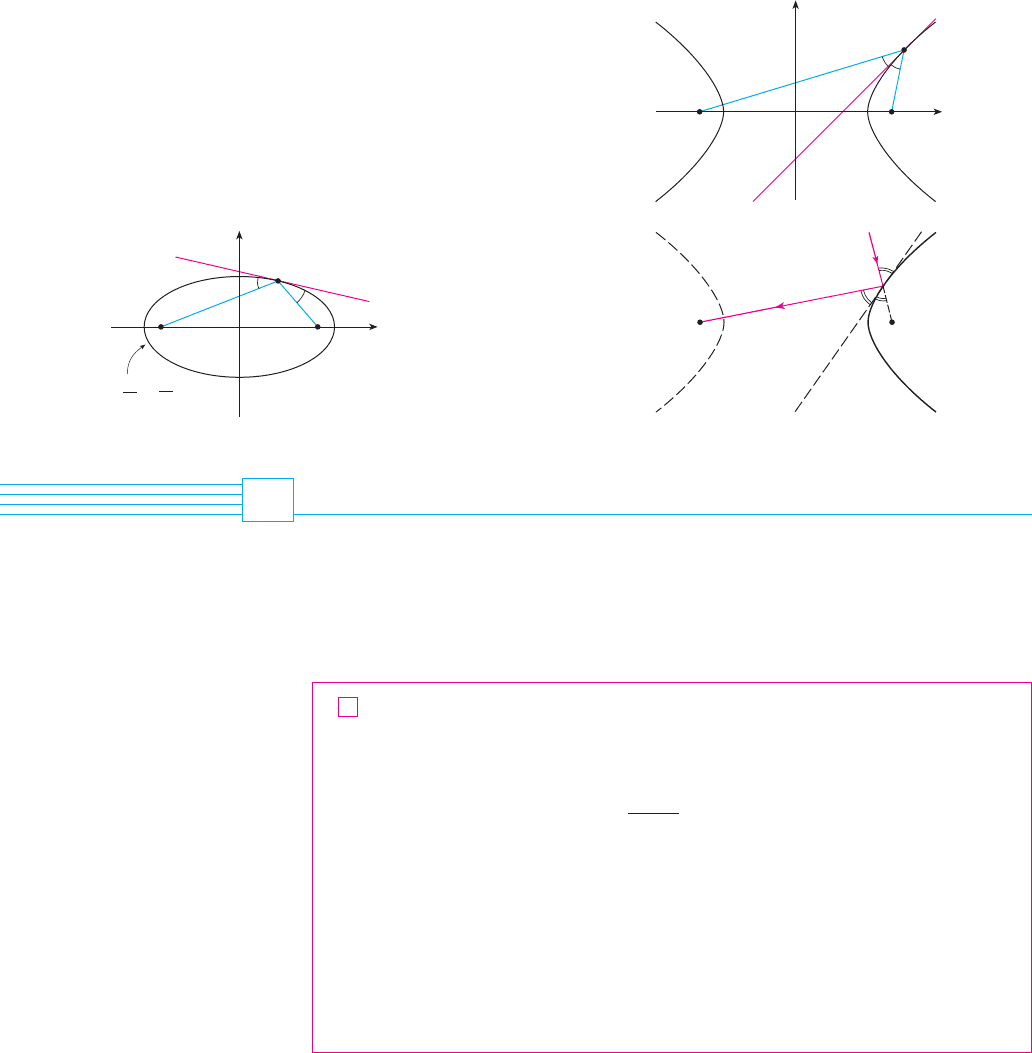
CONIC SECTIONS IN POLAR COORDINATES
In the preceding section we defined the parabola in terms of a focus and directrix, but we
defined the ellipse and hyperbola in terms of two foci. In this section we give a more uni-
fied treatment of all three types of conic sections in terms of a focus and directrix. Further-
more, if we place the focus at the origin, then a conic section has a simple polar equation,
which provides a convenient description of the motion of planets, satellites, and comets.
THEOREM Let be a fixed point (called the focus) and be a fixed line
(called the directrix) in a plane. Let be a fixed positive number (called the
eccentricity). The set of all points in the plane such that
(that is, the ratio of the distance from to the distance from is the constant )
is a conic section. The conic is
(a)
(b)
(c) a hyperbola if e ' 1
a parabola if e ! 1
an ellipse if e
&
1
elF
$
PF
$
$
Pl
$
! e
P
e
lF
1
11.6
and the length of the minor axis is km. Use Simp-
son’s Rule with to estimate the distance traveled by the
planet during one complete orbit around the sun.
61. Find the area of the region enclosed by the hyperbola
and the vertical line through a focus.
62. (a) If an ellipse is rotated about its major axis, find the volume
of the resulting solid.
(b) If it is rotated about its minor axis, find the resulting
volume.
63. Let be a point on the ellipse with
foci and and let and be the angles between the lines
,
and the ellipse as shown in the figure. Prove that
. This explains how whispering galleries and lithotripsy
work. Sound coming from one focus is reflected and passes
through the other focus. [Hint: Use the formula in Problem 15
on page 202 to show that .]
F¡ F™
0
x
y
∫
å
+ =1
≈
a@
¥
b@
P(⁄,›)
tan
(
! tan
)
(
!
)
PF
2
PF
1
)
(
F
2
F
1
x
2
#a
2
! y
2
#b
2
! 1P
1
!x
1
, y
1
"
x
2
#a
2
" y
2
#b
2
! 1
n ! 10
1.14 % 10
10
698
|| ||
CHAPTER 11 PARAMETRIC EQUATIONS AND POLAR COORDINATES
64. Let be a point on the hyperbola
with foci and and let and be the angles between the
lines , and the hyperbola as shown in the figure. Prove
that . (This is the reflection property of the hyperbola. It
shows that light aimed at a focus of a hyperbolic mirror is
reflected toward the other focus .)
0
x
y
å
∫
F™F¡
P
F™F¡
P
F
1
F
2
(
!
)
PF
2
PF
1
)
(
F
2
F
1
x
2
#a
2
" y
2
#b
2
! 1P!x
1
, y
1
"

SECTION 11.6 CONIC SECTIONS IN POLAR COORDINATES
|| ||
699
PROOF Notice that if the eccentricity is , then and so the given condi-
tion simply becomes the definition of a parabola as given in Section 11.5.
Let us place the focus at the origin and the directrix parallel to the -axis and
units to the right. Thus the directrix has equation and is perpendicular to the
polar axis. If the point has polar coordinates , we see from Figure 1 that
Thus the condition , or , becomes
If we square both sides of this polar equation and convert to rectangular coordinates,
we get
or
After completing the square, we have
If , we recognize Equation 3 as the equation of an ellipse. In fact, it is of the form
where
In Section 11.5 we found that the foci of an ellipse are at a distance from the center,
where
This shows that
and confirms that the focus as defined in Theorem 1 means the same as the focus defined
in Section 11.5. It also follows from Equations 4 and 5 that the eccentricity is given by
If , then and we see that Equation 3 represents a hyperbola. Just as we
did before, we could rewrite Equation 3 in the form
and see that
Mwhere c
2
! a
2
! b
2
e !
c
a
!x " h"
2
a
2
"
y
2
b
2
! 1
1 " e
2
&
0e ' 1
e !
c
a
c !
e
2
d
1 " e
2
! "h
c
2
! a
2
" b
2
!
e
4
d
2
!1 " e
2
"
2
5
c
b
2
!
e
2
d
2
1 " e
2
a
2
!
e
2
d
2
!1 " e
2
"
2
h ! "
e
2
d
1 " e
2
4
!x " h"
2
a
2
!
y
2
b
2
! 1
e
&
1
%
x !
e
2
d
1 " e
2
&
2
!
y
2
1 " e
2
!
e
2
d
2
!1 " e
2
"
2
3
!1 " e
2
"x
2
! 2de
2
x ! y
2
! e
2
d
2
x
2
! y
2
! e
2
!d " x"
2
! e
2
!d
2
" 2dx ! x
2
"
r ! e!d " r cos
*
"
2
$
PF
$
! e
$
Pl
$$
PF
$
#
$
Pl
$
! e
$
Pl
$
! d " r cos
*
$
PF
$
! r
!r,
*
"P
x ! dd
yF
$
PF
$
!
$
Pl
$
e ! 1
F I G U R E 1
y
x
F
l(directrix)
x=d
r cos¨
P
¨
r
d
C
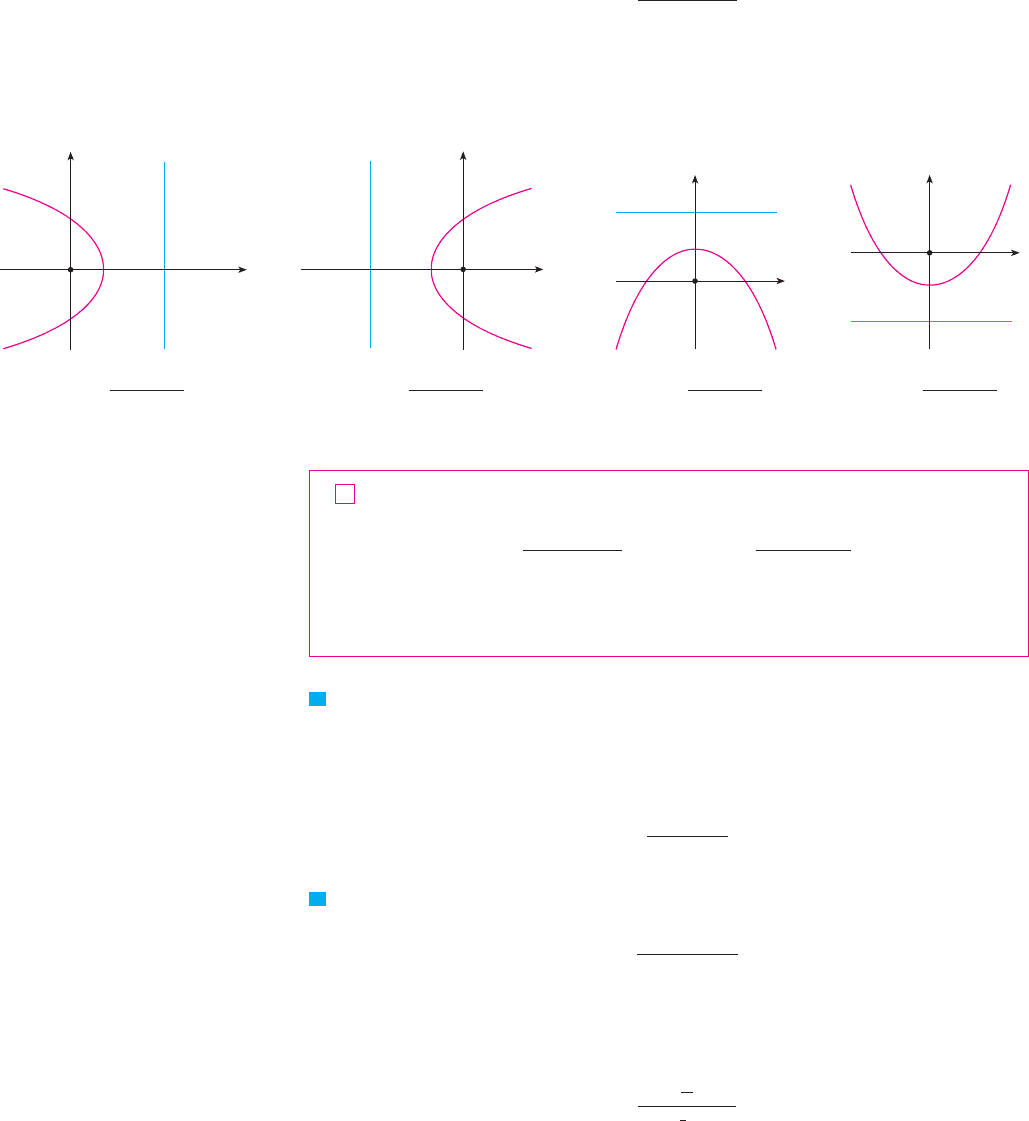
By solving Equation 2 for , we see that the polar equation of the conic shown in Fig-
ure 1 can be written as
If the directrix is chosen to be to the left of the focus as , or if the directrix is cho-
sen to be parallel to the polar axis as , then the polar equation of the conic is given
by the following theorem, which is illustrated by Figure 2. (See Exercises 21–23.)
THEOREM A polar equation of the form
represents a conic section with eccentricity . The conic is an ellipse if ,
a parabola if , or a hyperbola if .
EXAMPLE 1 Find a polar equation for a parabola that has its focus at the origin and
whose directrix is the line .
SOLUTION Using Theorem 6 with and , and using part (d) of Figure 2, we see
that the equation of the parabola is
M
EXAMPLE 2 A conic is given by the polar equation
Find the eccentricity, identify the conic, locate the directrix, and sketch the conic.
SOLUTION Dividing numerator and denominator by 3, we write the equation as
r !
10
3
1 "
2
3
cos
*
r !
10
3 " 2 cos
*
V
r !
6
1 " sin
*
d ! 6e ! 1
y ! "6
V
e ' 1e ! 1
e
&
1e
r !
ed
1 # e sin
*
orr !
ed
1 # e cos
*
6
F I G U R E 2
Polar equations of conics
(a) r=
ed
1+e cos¨
y
x
F
x=d
directrix
(b) r=
ed
1-e cos¨
x
F
y
x=_d
directrix
(c) r=
ed
1+e sin¨
y
F
x
y=d directrix
(d) r=
ed
1-e sin¨
x
y
y=_d directrix
F
y ! #d
x ! "d
r !
ed
1 ! e cos
*
r
700
|| ||
CHAPTER 11 PARAMETRIC EQUATIONS AND POLAR COORDINATES

SECTION 11.6 CONIC SECTIONS IN POLAR COORDINATES
|| ||
701
From Theorem 6 we see that this represents an ellipse with . Since ,
we have
so the directrix has Cartesian equation . When , ; when ! ,
. So the vertices have polar coordinates and . The ellipse is sketched
in Figure 3.
M
EXAMPLE 3 Sketch the conic .
SOLUTION Writing the equation in the form
we see that the eccentricity is and the equation therefore represents a hyperbola.
Since , and the directrix has equation . The vertices occur when
and , so they are and . It is also useful to
plot the -intercepts. These occur when , ; in both cases . For additional
accuracy we could draw the asymptotes. Note that when or
and when . Thus the asymptotes are parallel to the rays
and . The hyperbola is sketched in Figure 4.
M
When rotating conic sections, we find it much more convenient to use polar equations
than Cartesian equations. We just use the fact (see Exercise 77 in Section 11.3) that the
graph of is the graph of rotated counterclockwise about the origin
through an angle .
EXAMPLE 4 If the ellipse of Example 2 is rotated through an angle about the
origin, find a polar equation and graph the resulting ellipse.
SOLUTION We get the equation of the rotated ellipse by replacing with in the
equation given in Example 2. So the new equation is
We use this equation to graph the rotated ellipse in Figure 5. Notice that the ellipse has
been rotated about its left focus.
M
r !
10
3 " 2 cos!
*
"
+
#4"
*
"
+
#4
*
+
#4
V
(
r ! f !
*
"r ! f !
*
"
(
"
F I G U R E 4
r=
12
2+4sin¨
x
0
y
(6, π) (6, 0)
y=3 (directrix)
focus
”2,
’
π
2
”6,
’
π
2
*
! 11
+
#6
*
! 7
+
#6
sin
*
! "
1
2
1 ! 2 sin
*
! 00
"
1 ! 2 sin
*
l 0
!
r l #,
r ! 6
+
*
! 0x
!"6, 3
+
#2" ! !6,
+
#2"!2,
+
#2"3
+
#2
*
!
+
#2
y ! 3d ! 3ed ! 6
e ! 2
r !
6
1 ! 2 sin
*
r !
12
2 ! 4 sin
*
!2,
+
"!10, 0"r ! 2
+
*
r ! 10
*
! 0x ! "5
d !
10
3
e
!
10
3
2
3
! 5
ed !
10
3
e !
2
3
F I G U R E 5
11
_6
_5 15
r=
10
3-2 cos(¨-π/4)
r=
10
3-2 cos¨
F I G U R E 3
y
0
x
r=
10
3-2 cos¨
x=_5
(directrix)
(10, 0)
(2,π)
focus
